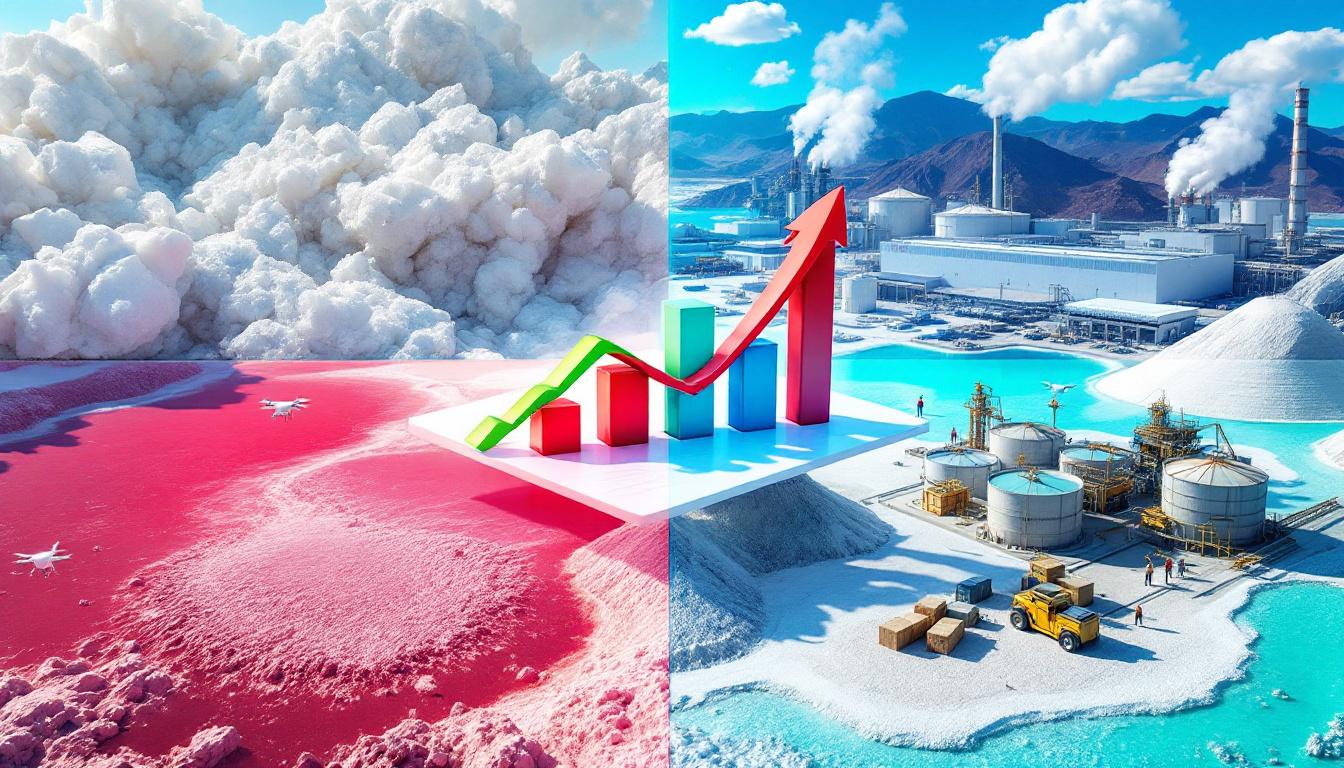What is Sphalerite and Why is it Gaining Attention in Critical Minerals?
Sphalerite, primarily composed of zinc sulfide (ZnS), is emerging as a focal point in the critical minerals sector due to its remarkable ability to host a diverse array of valuable elements. This mineral is gaining unprecedented attention as researchers and industry stakeholders recognize its potential as a single source for multiple critical materials.
According to CSIRO research conducted with Cornell University in 2023, sphalerite contains 14+ critical elements, including indium, gallium, and germanium—all vital components in modern technologies. What makes this particularly significant is that traditional mining operations have historically left up to 98% of ore material as waste, overlooking these valuable elements.
"Sphalerite is a very cool mineral because of its treasure trove of critical elements," explains Professor Karin Olson Hoal, Cornell University scholar and Fulbright Australia-US Chair in Science, Technology and Innovation during her collaboration with CSIRO.
The mineral's rising prominence aligns with growing demand for critical minerals energy transition—with indium essential for touchscreens experiencing an 8.5% CAGR through 2030, while global germanium production (used in fiber optics) remains under 1,000 tonnes annually compared to zinc's massive 12.8 million tonnes in 2023 (USGS, 2024).
This stark production disparity highlights why sphalerite processing represents such a valuable opportunity for sustainable resource development. By extracting multiple critical elements from a single mineral source, the industry can significantly reduce the environmental footprint of mining while supporting circular economy principles.
What Makes Sphalerite a "Very Cool Mineral"?
The Diverse Composition of Sphalerite
Sphalerite's exceptional nature stems from its unique chemical composition. While primarily zinc sulfide (ZnS), its crystal structure allows for remarkable elemental substitution without structural collapse. This characteristic enables sphalerite to host an impressive array of valuable elements including:
- Manganese, cadmium, and mercury
- Indium, thallium, gallium, and germanium
- Antimony, tin, and lead
- Silver and cobalt
This elemental diversity creates a visual spectrum ranging from nearly colorless (pure ZnS) to deep brown or even black when iron content exceeds 15% (Mindat.org, 2024). The mineral's color variation serves as a visual indicator of its compositional diversity.
At Alaska's Red Dog Mine, operated by Teck Resources, sphalerite contains approximately 50 ppm germanium—a seemingly minuscule amount that becomes economically significant when processing millions of tonnes of ore. This mine exemplifies how understanding sphalerite's "hidden" elements can create substantial value streams.
Geological Distribution and Formation
Sphalerite's geological versatility further contributes to its significance. As Professor Hoal notes, "It occurs in sedimentary deposits, ancient volcanic regions, and modern sea floors," demonstrating remarkable adaptability across geological settings.
Perhaps most fascinating is sphalerite's discovery in meteorites dating back approximately 4.5 billion years—making it one of the universe's enduring mineral formations. This cosmic presence provides valuable insights into ore-forming processes both on Earth and beyond.
The mineral forms through several distinct processes:
- Hydrothermal deposition – Where hot, mineral-rich fluids cool and deposit sphalerite
- Sedimentary processes – Through chemical precipitation in specific environmental conditions
- Contact metamorphism – When limestone undergoes thermal alteration from nearby magma
This geological diversity makes sphalerite both scientifically fascinating and economically valuable across various mining contexts.
How is Sphalerite Research Advancing Critical Minerals Recovery?
Historical Limitations in Mineral Processing
Traditional mining operations have long focused primarily on extracting main commodities like zinc, leaving most of the mineral matrix—and valuable trace elements—behind. This limited approach has created significant missed opportunities:
- Up to 98% of ore material often left behind as waste
- Limited characterization of whole ores for additional valuable elements
- Overlooked recovery potential for critical technology metals
- Pre-crushed, above-ground material at historic sites representing untapped resources
These historical limitations are particularly concerning given the increasing demand for technology metals. For example, indium—essential for touchscreens and solar panels—remains primarily a byproduct of zinc processing, with global supply chains vulnerable to disruption.
Modern Geometallurgical Approaches
The emergence of geometallurgy—linking geological information with engineering processes—represents a paradigm shift in how we approach complex minerals like sphalerite. This integrated approach delivers multiple benefits:
- Enhanced recovery rates: Geometallurgical modeling has improved element recovery by 15-30% in several operations
- Reduced processing costs: Studies indicate cost reductions of $5-10 per tonne of processed ore (CRIRSCO, 2024)
- Minimized environmental impact: More precise processing reduces waste generation and resource consumption
- Optimized extraction sequencing: Based on detailed mineralogical understanding
"By linking geology with engineering processes, we reduce risk and create sustainable opportunities that benefit communities and the environment," explains Professor Hoal.
Modern techniques like microtextural zoning analysis and hyperspectral imaging enable real-time characterization of sphalerite samples, allowing processors to identify zones rich in specific elements and tailor extraction methods accordingly.
How Does Geometallurgy Transform Mining Practices?
Integrating ESG Principles into Resource Recovery
Geometallurgy serves as a bridge between traditional mining practices and modern Environmental, Social, and Governance (ESG) expectations. This integration manifests in several ways:
- Environmental footprint reduction: More efficient extraction means less waste generation
- Maximized value from existing mine sites: Extending operational lifespans without new land disturbance
- Reclamation opportunities: Extracting value from historical slag heaps and tailings
- Reduced energy and water consumption: Through optimized processing workflows
According to CSIRO research, geometallurgical approaches can reduce processing waste by 30-50% compared to conventional methods. This dramatic improvement addresses one of mining's most significant environmental challenges while simultaneously improving economic outcomes.
Connecting Geology with Engineering Solutions
The true power of geometallurgy lies in bridging traditionally separate disciplines:
- Geological understanding: Detailed mineralogical characterization identifies element distribution
- Process engineering: Customized extraction methods target specific elements
- Economic modeling: Optimized recovery based on market values and processing costs
- Environmental management: Minimized waste generation and resource consumption
This integrated approach enables miners to make informed decisions about which elements to target and how to process complex minerals like sphalerite most effectively. For example, BHP's Olympic Dam operation reportedly improved copper recovery by 15% through geometallurgical modeling, demonstrating the approach's real-world value.
What is the Role of Academic-Industry Collaboration in Advancing Sphalerite Research?
The CSIRO-Cornell University Partnership
The collaboration between Professor Karin Olson Hoal and CSIRO exemplifies the power of academic-industry partnerships in advancing mineral science. As part of her six-month Fulbright Australia-US Chair in Science, Technology and Innovation appointment, Professor Hoal brings extensive expertise in geometallurgy to CSIRO's established minerals research program.
This partnership focuses specifically on:
- Applying geometallurgical expertise to ESG-aligned mining activities
- Unlocking the potential of complex minerals like sphalerite
- Ensuring "the whole minerals value chain gains full value" from extracted resources
The Fulbright program, providing approximately $50,000 in funding for such scholarly exchanges (Fulbright Commission, 2024), represents an investment in knowledge transfer that benefits both academic understanding and industrial application.
Benefits of Cross-Disciplinary Approaches
Cross-disciplinary collaboration creates unique advantages in advancing mineral science:
- Accelerated innovation: Combining academic research with practical applications
- Expanded knowledge base: Integrating perspectives from geology, engineering, and economics
- Enhanced problem-solving: Addressing complex challenges through diverse expertise
- Broader impact: Translating research into industry-wide practices
Previous partnerships, such as Rio Tinto's collaboration with CSIRO on automated mineralogy (Rio Tinto, 2022), demonstrate how these cross-disciplinary approaches translate to operational improvements. Professor Hoal's 25+ publications on ore systems (Google Scholar) further validate the scientific credibility she brings to this partnership.
How Does Sphalerite Research Support the Circular Economy?
Maximizing Resource Value
Sphalerite research directly supports circular economy principles by approaching mineral resources as part of a continuous cycle rather than a linear extract-use-dispose model. This paradigm shift enables:
- Multi-element recovery: Extracting numerous valuable components from a single source
- Waste stream valorization: Converting traditional "waste" into valuable resources
- Extended material lifecycles: Keeping minerals in circulation longer
- Reduced primary extraction needs: Lessening environmental impact of new mining
According to UNEP (2023), reprocessing existing tailings could supply up to 20% of global germanium demand—a significant contribution to meeting technology metal needs without additional land disturbance.
"Extraction brings minerals into circulation for humanity, and our goal is to maximize their value long-term," notes Professor Hoal, highlighting the circular thinking underpinning modern approaches to sphalerite.
Creating Sustainable Mineral Value Chains
The application of advanced sphalerite processing creates more sustainable mineral value chains through:
- Improved resource utilization efficiency: Extracting more value from each tonne of processed material
- Reduced waste generation: Minimizing tailings and processing residues
- Lower energy and water consumption: Through optimized extraction sequences
- Extended mine lifespans: Creating economic sustainability for mining communities
Real-world examples like Glencore's Kidd Creek operation in Canada demonstrate this approach in action, with the company successfully recovering cadmium and silver from historic zinc processing waste, creating new value while addressing historical environmental liabilities.
What Are the Economic Implications of Advanced Sphalerite Processing?
Unlocking New Value Streams
Advanced sphalerite processing creates significant economic opportunities through:
- Recovery of overlooked critical elements: Generating new revenue streams
- Diversified product portfolios: Reducing dependency on single-commodity pricing
- Lower-grade resource viability: Making previously uneconomic deposits profitable
- Extended operational lifespans: For existing mining operations
The economics are compelling—Wood Mackenzie (2023) reports that indium recovery can add $50-100 per tonne in additional revenue to zinc operations. Similarly, Teck's Trail Operations generates approximately $200 million annually from byproduct selenium and tellurium, demonstrating the material financial impact of comprehensive mineral utilization.
Market Opportunities for Critical Minerals
Global market trends strongly favor advanced sphalerite processing:
- Germanium price: $1,800/kg (up 40% since 2020) according to USGS (2024)
- Critical minerals market: Projected to reach $500 billion by 2030 (PwC, 2023)
- Supply security concerns: 80% of gallium production concentrated in China
- Technological demand growth: Driven by renewable energy, electronics, and defense applications
These market conditions create strong economic incentives for developing more sophisticated approaches to sphalerite processing, particularly as nations seek to secure domestic supplies of technology metals previously imported from concentrated supply regions.
FAQ: Understanding Sphalerite and Critical Minerals Recovery
What makes certain elements in sphalerite "critical"?
Critical minerals are those essential for economic and national security but vulnerable to supply disruption. Elements found in sphalerite like gallium (used in semiconductors), germanium (fiber optics), and indium (touchscreens) are designated as critical because:
- They're essential for advanced technologies including renewable energy and defense systems
- They have few or no substitutes in their applications
- Their production is often geographically concentrated (e.g., China controls 80% of gallium production)
- They're typically byproducts rather than primary mining targets
This combination of high importance and supply vulnerability creates their "critical" designation.
How does sphalerite processing support sustainability goals?
Advanced sphalerite processing supports sustainability through multiple mechanisms:
- Resource efficiency: Extracting multiple elements from a single mineral source
- Waste reduction: Converting processing residues into valuable products
- Land use minimization: Reducing need for new greenfield mining operations
- Energy and water efficiency: Through optimized extraction techniques
By applying geometallurgical principles, processors can reduce waste by 30-50% while significantly increasing the value extracted from each tonne of ore processed—creating both environmental and economic benefits. This approach aligns perfectly with sustainable mining transformation goals being implemented across the industry.
What technologies are being developed to better process sphalerite?
Several cutting-edge technologies are advancing sphalerite processing capabilities:
- Hyperspectral imaging: For rapid, non-destructive mineral characterization
- Laser ablation ICP-MS: Providing precise elemental mapping within mineral grains
- Selective leaching processes: Targeting specific elements while leaving others intact
- Advanced flotation techniques: Improving separation of valuable minerals
- Automated mineralogy systems: Enabling real-time process adjustments
These technologies enable processors to identify, target, and extract valuable elements from sphalerite with unprecedented precision and efficiency. Furthermore, these advancements represent significant mining industry innovation that is transforming resource extraction globally.
How might sphalerite research impact future mining operations?
Sphalerite research is likely to transform mining operations through:
- Comprehensive elemental characterization: Standard practice for all new projects
- Multi-product business models: Moving beyond single-commodity operations
- Integration of circular principles: From initial design through closure planning
- Tailings reprocessing circuits: Becoming standard components of processing facilities
Future operations will likely approach sphalerite not merely as a zinc ore but as a complex, multi-element resource requiring sophisticated, tailored processing approaches to maximize both economic and sustainability outcomes. This shift creates significant mineral beneficiation opportunities while also enabling more effective mine reclamation innovation through more comprehensive resource utilization.
Disclaimer: The economic projections and market trends discussed in this article are based on current data and expert analysis but remain subject to change due to technological developments, regulatory shifts, and market dynamics. Readers should consult multiple sources when making investment or business decisions related to mineral processing.
Want to Spot the Next Major Mineral Discovery?
Stay ahead of the market with Discovery Alert's proprietary Discovery IQ model, delivering instant notifications when significant mineral discoveries are announced on the ASX. Explore why historic discoveries can generate substantial returns by visiting Discovery Alert's dedicated discoveries page and begin your 30-day free trial today.




